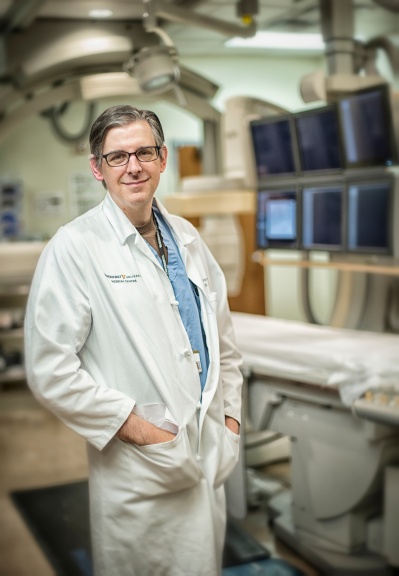Our Faculty Spotlight section includes an interview with Dr. Dan Brown, Director of Interventional Oncology, a subspecialty within Interventional Radiology (IR).When we surveyed current 4th-year students, asking them which specialties they wish they had obtained more exposure to during medical school, the most popular answers were Interventional Radiology (IR) and Physical Medicine and Rehabilitation (PM&R). We are therefore very grateful that Dr. Brown greed to share more about his field.
1) What is your given role and title?
Director of Interventional Oncology. Interventional Oncology is a subspecialty of Interventional Radiology (IR).
2) Why did you choose Interventional Radiology?
I liked the integration of imaging as a navigational tool to perform procedures. The procedures developed in IR were several generations technically ahead of many other specialties. The ability to perform valuable and sometimes life -‐ saving interventions on patients through a 2 mm incision was striking especially after seeing patients recover from large surgical incisions.
3) Were you deciding between it and other fields?
I was strongly considering Interventional Cardiology as there is inherent overlap between these two areas. Cardiology is a great specialty, but the greater diversity of procedures in IR got me hooked.
4) Many VMS students have expressed interest in learning more about IR. Can you tell us more about this field, about interventional oncology in particular, and what your typical day (if there is such a thing) is like?
I have been allowed to develop a practice focused on oncology because of the support of my associates in IR and the vision of my chair, Dr. Omary. My weekly schedule includes up to four tumor board sessions in GI oncology, Liver Transplant, Neuroendocrine, and Sarcoma. As we add faculty, I look forward to seeing this part of our schedule expand. We see new and follow-‐up patients in clinic at the Vanderbilt Ingram Cancer Center. We usually have 2-4 procedures/day on service. Although most patients are treated as outpatients, we admit to our service when needed. Fortunately, we have a tremendous Nurse and Nurse Practitioner on hand to help juggle everything from scheduling to triaging questions that come up before and after procedures. Once the Interventional Oncology cases are completed, I try to help with the remaining IR cases on the schedule.
5) What does the training path consist of? (how many years are residency and fellowship? are there different paths to reach this end goal?)
This question is very timely! Interventional Radiology was recently made a primary specialty by the American Board of Medical Specialties (ABMS). Vanderbilt is going through the certification process to be one of the first programs in the Integrated Training paradigm. Following a surgical internship at Vanderbilt, candidates complete 3 years of core radiology training followed by two years of interventional radiology training. Graduates of these programs will be certified both in Diagnostic and Interventional Radiology. During the transition period traditional 1-‐year fellowships following a 4-‐year residency will continue to be offered. Vanderbilt’s Diagnostic Radiology Residency did very well in the recent NRMP match, filling all spots near the very top of its list.
6) What is your favorite part about your job/your specialty?
There are several things that are very satisfying from a patient and educational perspective:
• When a patient comes back to clinic and the images show a great response to treatment.
• When the same patient tells us that the recovery was so easy, it was like not even going through a procedure.
• Doing research and writing with medical students and residents. A Vanderbilt medical student, Mary Ellen Koran, won a research award at this year’s Society of Interventional Radiology meeting. It was very rewarding as a mentor to see such as accomplishment. We have multiple ongoing or completed projects with medical students, from review articles to outcomes measurements.
7) What is the most challenging part about your job/your specialty?
The most difficult aspect is that we can’t treat everybody that is referred. Although procedures such as radioembolization of liver tumors are minimally-‐invasive, if a patient has severe liver dysfunction, we can actually hurt rather than help. I recently saw a patient interested in tumor ablation of metastatic sarcoma who had a tumor surrounded by large blood vessels and bowel. Had I treated her, she could have suffered a terrible injury. For a patient who is understandably looking for any option to survive, these types of conversations can be very difficult.
8) What’s the biggest stereotype about your specialty? Is it true?
The biggest commentary on Interventional Oncology centers on the lack of “big data”. Historically, this has been an issue, but is improving. Treatment guidelines from the National Cancer Center Networks are centered on evidence-‐based medicine and our treatments are part of the guidelines on Hepatobiliary, Neuroendocrine, and Renal tumors. There are also a number of ongoing prospective randomized trials evaluating use of liver-‐directed therapy with colorectal cancers and networks of large-‐volume centers are coming together. These factors make the future very exciting.
9) What advice do you have for VMS students considering IR as a future specialty?
There are dedicated IR rotations at Vanderbilt. Someone who is considering a career in IR should complete such a rotation. Peter Bream is the contact for student rotations. A number of students have also shadowed one of the IR physicians or me for a day to get a feel. Finally, members of the IR division are happy to speak with students offline to discuss relevant issues. My email is daniel.b.brown@vanderbilt.edu. Finally, there is a student-‐run Interventional Radiology Interest Group. This group provides networking opportunities with other interested students, residents,and fellows.
